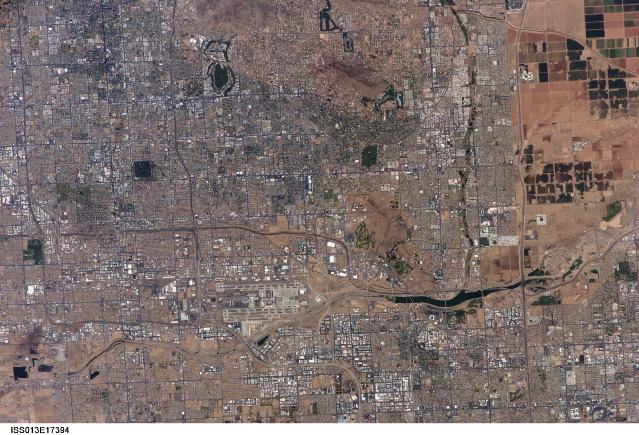| Home >> | Advanced Search >> |
 |
|
Astronaut Photography of Earth - Display Record
ISS013-E-17394

Low-resolution Browse Image
(Most browse images are not color adjusted.)Images
Conditions for Use of Images >>Image Transformation Tutorial >> Saving, Color Adjusting, and Printing Images >>
Images to View on Your Computer Now
| File Name | File Size (bytes) | Width | Height | Annotated | Cropped | Purpose | Comments | |
|---|---|---|---|---|---|---|---|---|
| View | ISS013-E-17394.JPG | 145303 | 639 | 435 | No | No | ||
| View | ISS013-E-17394.JPG | 408698 | 540 | 373 | Yes | Yes | NASA's Earth Observatory web site |
Large Images to Request for Downloading
| File Name | File Size (bytes) | Width | Height | Annotated | Cropped | Purpose | Comments | |
|---|---|---|---|---|---|---|---|---|
| Request | ISS013-E-17394.JPG | 1267259 | 1000 | 690 | No | Yes | NASA's Earth Observatory web site | |
| Request | ISS013-E-17394.JPG | 2742683 | 3032 | 2064 | No | No |
Download a Keyhole Markup Language (KML) file for use in Google Earth.
Electronic Image Data
Camera Files >> No sound file available.Identification
Mission: ISS013 Roll: E Frame: 17394 Mission ID on the Film or image: ISS013Country or Geographic Name: USA-ARIZONA
Features: PHOENIX,SALT RIVER,TEMPE
Center Point Latitude: 33.5 Center Point Longitude: -111.9 (Negative numbers indicate south for latitude and west for longitude)
Stereo: (Yes indicates there is an adjacent picture of the same area)
ONC Map ID: JNC Map ID:
Camera
Camera Tilt: 13Camera Focal Length: 400mm
Camera: E4: Kodak DCS760C Electronic Still Camera
Film: 3060E : 3060 x 2036 pixel CCD, RGBG array.
Quality
Film Exposure:Percentage of Cloud Cover: 10 (0-10)
Nadir
Date: 20060510 (YYYYMMDD)GMT Time: 193513 (HHMMSS)Nadir Point Latitude: 33.4, Longitude: -111.2 (Negative numbers indicate south for latitude and west for longitude)
Nadir to Photo Center Direction: West
Sun Azimuth: 192 (Clockwise angle in degrees from north to the sun measured at the nadir point)
Spacecraft Altitude: 186 nautical miles (344 km)
Sun Elevation Angle: 74 (Angle in degrees between the horizon and the sun, measured at the nadir point)
Orbit Number: 2727
Captions
Central Phoenix Metro Area, ArizonaThe Phoenix, Arizona, metropolitan area is the largest in the southwestern United States. The city is made up of 21 contiguous (connected through an unbroken sequence) incorporated municipalities. When discrete political entities form a larger, integrated urban landscape, geographers call the arrangement a conurbation. This astronaut photograph (upper image) of the central metro region includes the boundary area between three of the municipalities included in the conurbation: the cities of Phoenix (left), Tempe (center and lower right), and Scottsdale (upper right). This high-resolution astronaut image has a spatial resolution (level of detail) of about 9 meters per image pixel. A regional view of the greater Phoenix metropolitan area is also available from the Earth Observatory.
The urban area is still expanding along its fringes, but significant redevelopment is also ongoing in “landlocked” municipalities in the center of the metro area, where expansion is not possible (such as Tempe). Residential areas are grey and gridded into blocks, commercial or industrial sectors often have highly reflective white rooftops, desert soils and rock exposures are brown, vegetation is dark green, and water is black. Comparison of the astronaut image with Landsat Thematic Mapper data (lower image) acquired in 1990 reveals changes in the region over 16 years.
Perhaps the most striking change visible in this image pair is the appearance of Tempe Town Lake, filled in 1999 (upper image, right). The lake was created in the usually dry Salt River channel (dry because the river has been impounded upstream behind Roosevelt Dam since 1911). The lake is part of a plan to develop the Tempe portion of the channel and adjacent floodplain. Contained by inflatable dams to accommodate releases from Roosevelt Dam, the lake holds a nominal water volume of approximately 1 billion gallons, with an estimated 620 million gallons lost to evaporation each year. Other visible changes between 1990 and 2006 include development of land surrounding Sky Harbor Airport, expansion of the airport itself (a third runway, begun in 1997, is visible in the astronaut photograph), and completion of major highways to the southwest of Papago Park and to the east of Tempe Town Lake (upper image, right boundary). Study of the effects of urban modifications in the Phoenix metro area and the surrounding Sonoran Desert ecosystem is the focus of the Central Arizona-Phoenix Long Term Ecological Research site based at Arizona State University.
While suburbs and skyscrapers are the latest expression of civilization in this portion of the Sonoran Desert, it is not the first large-scale modification of the area to serve human needs. The Hohokam society cultivated the region and created an extensive network of irrigation canals between AD 300 and 1450. The canals remained long after the Hohokam themselves quit the region, and settlers used them in the 19th century to irrigate their fields with water from the Salt River.
Download Packaged File.
This option downloads the following items, packaged into a single file, if they are available:
- Browse image
- Cataloged information with captions
- Camera file
- Sound file
Server: 2 |
This service is provided by the International Space Station program. |

